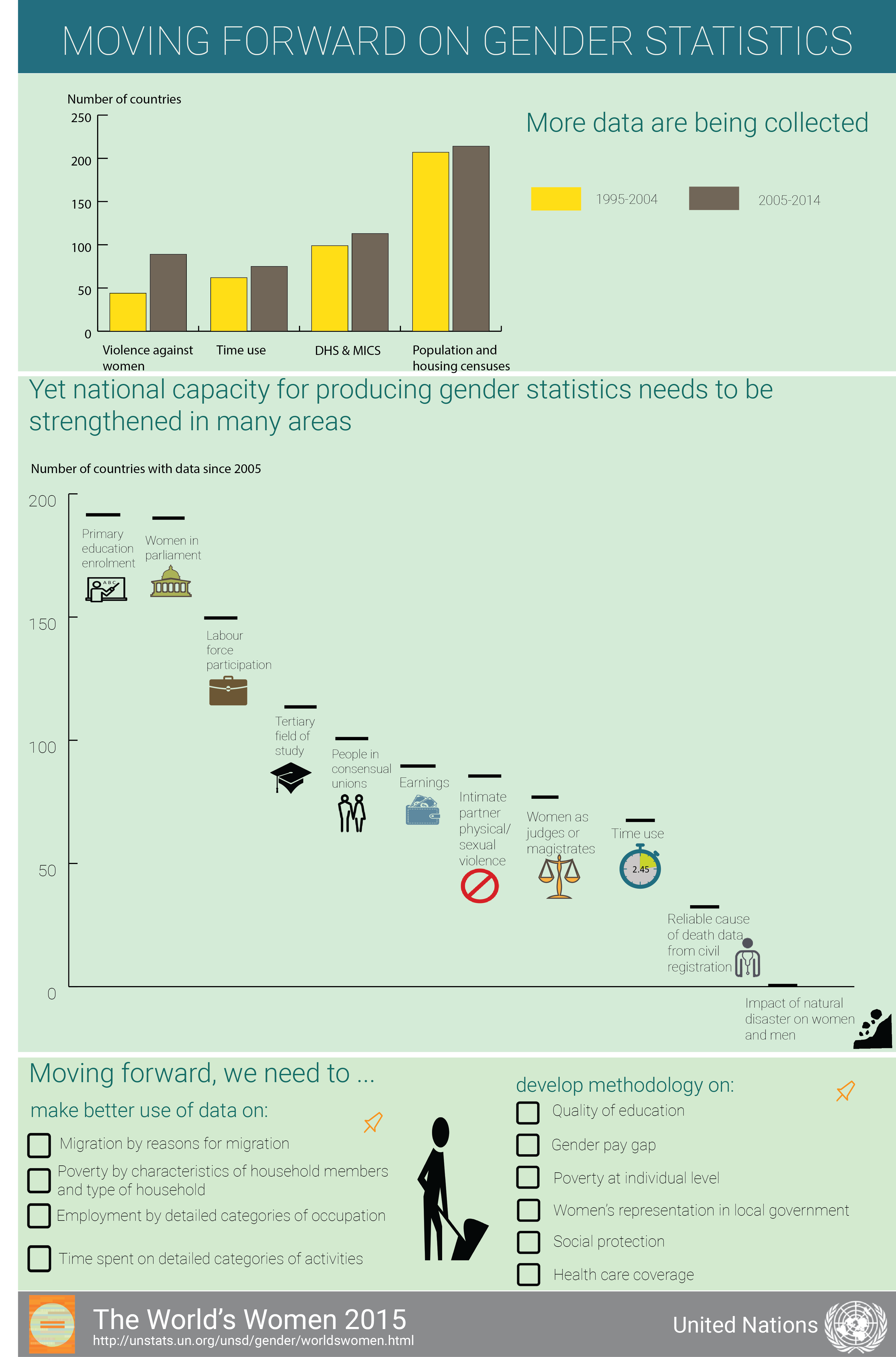Availability of data for gender analysis has increased
Relevant, reliable and timely gender statistics—cutting across traditional fields of statistics, including education, health and employment as well as emerging ones, such as climate change— are essential to understanding the differences between women and men in a given society. Such information is critical to policy- and decision-makers and to advancing progress towards gender equality.
The World’s Women 2015 has benefited from the growing availability of gender statistics. Because more countries are conducting household surveys, in addition to regular population censuses, the majority of them can produce at present data disaggregated by sex for basic indicators on population, families, health, education and work. Many more surveys are presently available on critical areas such as violence against women: 89 countries collected data on this topic through household surveys during the period 2005–2014 compared to only 44 in the previous decade. Furthermore, gender statistics based on administrative records are becoming more widely available. For instance, statistics on women’s representation in lower or single houses of parliament are available for 190 countries in 2015, an increase from 167 countries in 1997.
… yet major gaps still exist in terms of availability and comparability
Despite improvements over time, gender statistics are still far from satisfactory and many gaps exist in terms of data availability, quality, comparability and timeliness, even for basic indicators. For example, according to the latest data reporting at the international level, only 46 countries were able to provide reliable statistics on deaths disaggregated by sex, based on civil registration systems, at least once for the period 2011–2014. Less than half of all developing countries have information disaggregated by sex on labour force participation, unemployment, status in employment, and employment by occupation for at least two points over the period 2005–2014.
Measuring gender equality in areas such as environment and poverty is even more challenging. Links between gender and environment have been assessed based on qualitative or small-scale quantitative studies and cannot be extrapolated to a whole society or across countries. Household- level data on poverty, measured traditionally on the basis of either income or household consumption, do not account for the distribution of resources within households. Thus they do not allow for an assessment of poverty at the individual level, which is needed for the production of relevant gender statistics.
The comparability of gender statistics at national and international levels is also problematic, mostly due to differences in sources, definitions, concepts and methods used to obtain the data. For example, the comparability of data on earnings is affected greatly by the data source used. Establishment surveys sometimes exclude workers in small enterprises and in the informal sector. Labour force surveys, although they cover all types of workers, have to rely on selfreported wages, which may introduce reporting errors. Comparability of data is also affected by the concepts and methods used to produce them, including how questions are phrased. For instance, the way in which women are interviewed about violence may affect their willingness and capacity to disclose their experience, undermining the quality of the data produced and also their international comparability.
Even when information is collected, it is often not tabulated and disseminated to allow for meaningful gender analysis
Yet another shortcoming is the fact that the information collected is often not exploited sufficiently for gender analysis. Data are frequently tabulated and disseminated in categories that are not relevant or are too broad to adequately reflect gender issues. For example, assessing gender segregation in the labour market is often hampered by the lack of employment data in detailed occupational categories. Another example of the underutilization of existing data relates to information collected through time-use surveys. Although data are most often collected by detailed categories of activities, published data on time use are often limited to broad categories only. Separate categories for time spent on collecting water and firewood, for example, are not often available, making it difficult to assess the impact of these specific activities on the work burden of women and men.
New statistical standards and methods have been developed
New methodological guidelines have been produced by international organizations, with the aim to improve the availability, quality and international comparability of gender statistics. The most recent guidelines include the Handbook on Integrating a Gender Perspective into Statistics (2015); Guidelines for Producing Statistics on Violence against Women (2014); Methodological Guidelines for the Gender Analysis of National Population and Housing Census Data (2014); and the Handbook on Developing Gender Statistics: A Practical Tool (2010). Another ongoing effort, undertaken by the Evidence and Data for Gender Equality (EDGE) project, is developing methodologies to measure asset ownership and entrepreneurship from a gender perspective. The project is being implemented by the UN Statistics Division in collaboration with UN-Women. Furthermore, the International Labour Organization is developing statistical guidelines to collect data on work. The guidelines reflect the definition adopted by the 2013 International Conference of Labour Statisticians, encompassing all forms of work, including own-use production of goods and services, which is particularly relevant for gender analysis.
Another achievement towards the standardization of methods and harmonization of indicators is the 2013 agreement by the United Nations Statistical Commission to use the Minimum Set of Gender Indicators, consisting of 52 quantitative and 11 qualitative indicators, as a guide for national production and international compilation of gender statistics.
… but additional guidance is needed
Statistical methods and gender statistics are still lagging behind in many subject areas including: decision-making positions in local government and in the private sector; poverty based on individual-level data; the quality of education and lifelong learning; the gender pay gap; social protection measures, including pensions and unemployment benefits; universal health coverage; and the impact of natural disasters. Producing relevant, accurate and timely gender statistics remains a challenge for many countries. Initiatives to develop statistical standards and national capacity, particularly on integrating a gender dimension into official statistics, should therefore be undertaken on a priority basis.
